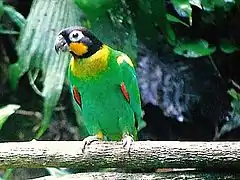| Pyrilia | |||
| Bonaparte, 1856[1] | |||
 Przedstawiciel rodzaju – barwinka złotolica (P. barrabandi) | |||
| Systematyka | |||
| Domena | |||
|---|---|---|---|
| Królestwo | |||
| Typ | |||
| Gromada | |||
| Podgromada | |||
| Infragromada | |||
| Rząd | |||
| Rodzina | |||
| Podrodzina | |||
| Plemię | |||
| Rodzaj |
Pyrilia | ||
| Typ nomenklatoryczny | |||
|
Psittacula pyrilia Bonaparte, 1853 | |||
| Synonimy | |||
|
| |||
| Gatunki | |||
| |||
Pyrilia – rodzaj ptaków z podrodziny papug neotropikalnych (Arinae) w obrębie rodziny papugowatych (Psittacidae).
Zasięg występowania
Morfologia
Długość ciała 21–25 cm; masa ciała 121–190 g[8].
Systematyka
Etymologia
- Pyrilia: epitet gatunkowy Psittacula pyrilia Bonaparte, 1853; gr. πυρ pur, πυρος puros „ogień”; łac. ilia „boki”, od ile „bok” (por. średniowiecznołac. pyralia „pochodnie”)[9].
- Caica: karibska/gujańska nazwa Caica dla długoogonowej papugi[9]. Gatunek typowy: Psittacus histrio Boddaert, 1785 (= Psittacus caica Latham, 1790).
- Gypopsitta (Gypopsittacus): gr. γυψ gups, γυπος gupos „sęp”; nowołac. psitta „papuga”, od gr. ψιττακη psittakē „papuga”[9]. Gatunek typowy: Psittacus vulturinus Wagler, 1832 (= Psittacus vulturinus Kuhl, 1820).
- Eucinetus: gr. ευκινητος eukinētos „zwinny, mobilny”, od ευ eu „dobry”; κινεω kineō „ruszać się”[9]. Gatunek typowy: Psittacus histrio Boddeart, 1785 (= Psittacus caica Latham, 1790).
- Chapmania: Frank Michler Chapman (1864–1945), amerykański ornitolog[9]. Gatunek typowy: Psittacus barrabandi Kuhl, 1820; młodszy homonim Chapmania Monticelli, 1893 (Foraminifera).
- Chapmaniana: rodzaj Chapmania Miranda-Ribeiro, 1920; łac. przyrostek -ana „odnoszące się do”[9]. Nowa nazwa dla Chapmania Miranda-Ribeiro, 1920.
Podział systematyczny
Do rodzaju należą następujące gatunki[10]:
- Pyrilia haematotis (P.L. Sclater & Salvin, 1860) – barwinka okularowa
- Pyrilia pulchra (von Berlepsch, 1897) – barwinka różowolica
- Pyrilia pyrilia (Bonaparte, 1853) – barwinka złotogłowa
- Pyrilia caica (Latham, 1790) – barwinka kapturowa
- Pyrilia barrabandi (Kuhl, 1820) – barwinka złotolica
- Pyrilia aurantiocephala (Gaban-Lima, M.A. Raposo & Höfling, 2002) – barwinka gołogłowa
- Pyrilia vulturina (Kuhl, 1820) – barwinka sępia
Przypisy
- ↑ Ch.L. Bonaparte. Note sur les Tableaux des Gallinacés. „Comptes Rendus hebdomadaires des séances de l’Académie des Sciences”. 42, s. 956, 1856. (fr.).
- ↑ G.R. Gray: Catalogue of the genera and subgenera of birds contained in the British Museum. London: Printed by order of the Trustees, 1855, s. 88. (ang.).
- ↑ Ch.L. Bonaparte. Tabellarische Uebersicht der Papagaien. „Naumannia”. 6, s. genus 25, 1856. (fr.).
- ↑ A. Reichenow. Conspectus Psittacorum. Systematische Uebersicht aller bekannten Papageienarten. „Journal für Ornithologie”. Vierte Folge. 29, s. 353, 1881. (niem.).
- ↑ T. Salvadori: Catalogue of the Birds in the British Museum. Cz. 20: Psittaci, or Parrots. London: Printed by order of the Trustees, 1891, s. 349. (ang.).
- ↑ A. de Miranda-Ribeiro. Revisão dos Psittacideos brasileiros. „Revista do Museu Paulista”. 12 (2), s. 10, 65, 1920. (hiszp.).
- ↑ E. Strand. Miscellanea nomenclatorica zoologica et palaeontologica. „Archiv für Naturgeschichte”. Abteilung A. 92 (8), s. 58, 1928. (niem.).
- 1 2 D.W. Winkler, S.M. Billerman & I.J. Lovette: New World and African Parrots (Psittacidae), version 1.0. W: S.M. Billerman, B.K. Keeney, P.G. Rodewald & T.S. Schulenberg (red.): Birds of the World. Ithaca, NY: Cornell Lab of Ornithology, 2020. DOI: 10.2173/bow.psitta3.01. [dostęp 2020-10-18]. (ang.).

- 1 2 3 4 5 6 Etymologia za: James A. Jobling: The Key to Scientific Names. [w:] Birds of the World [on-line]. Cornell Laboratory of Ornithology, Ithaca, NY, USA, 2021. (ang.).
- ↑ Systematyka i nazwy polskie za: P. Mielczarek & M. Kuziemko: Plemię: Amazonini Des Murs, 1886 (wersja: 2023-09-28). [w:] Kompletna lista ptaków świata [on-line]. Instytut Nauk o Środowisku Uniwersytetu Jagiellońskiego. [dostęp 2023-11-23].
This article is issued from Wikipedia. The text is licensed under Creative Commons - Attribution - Sharealike. Additional terms may apply for the media files.